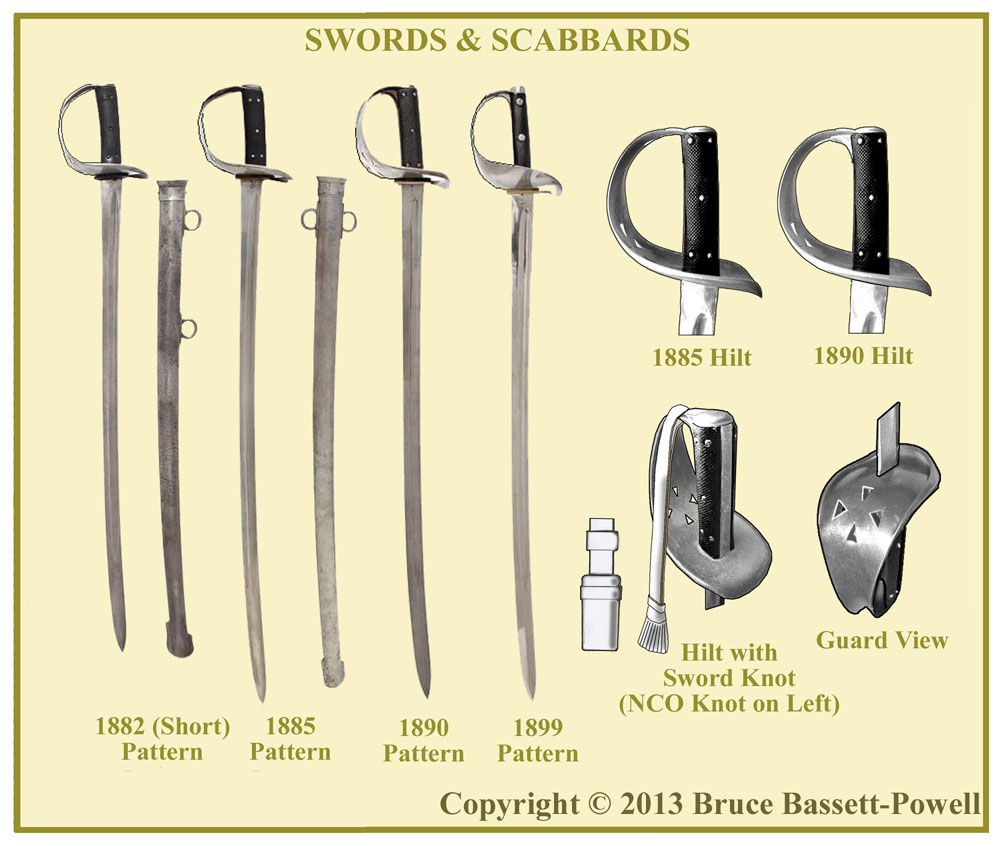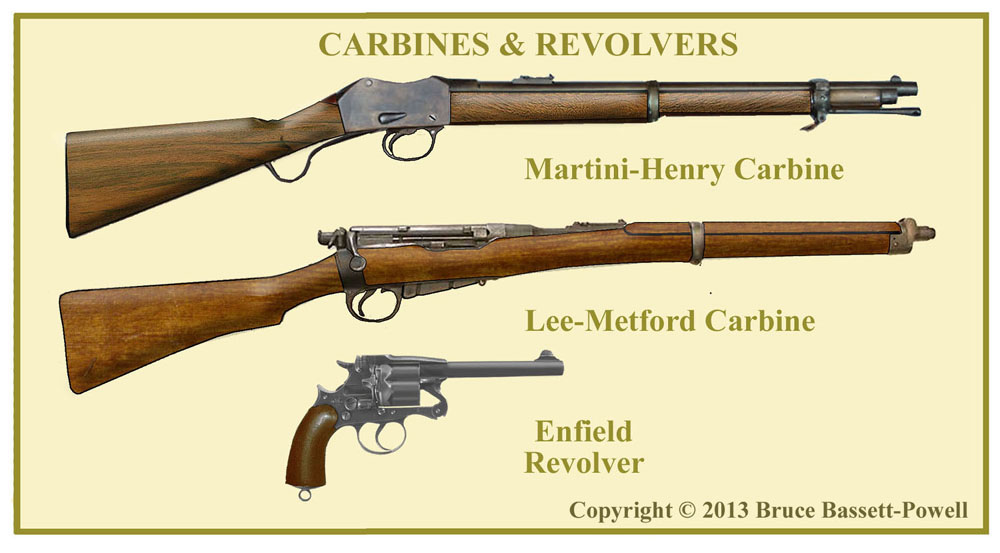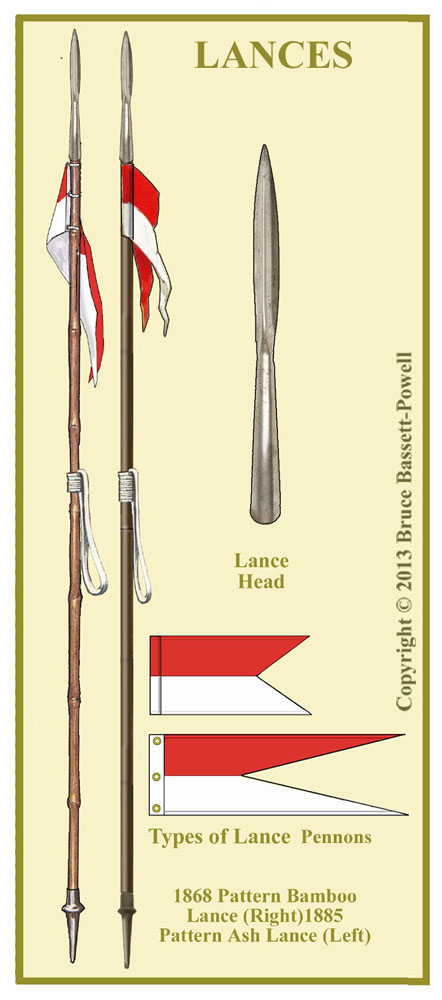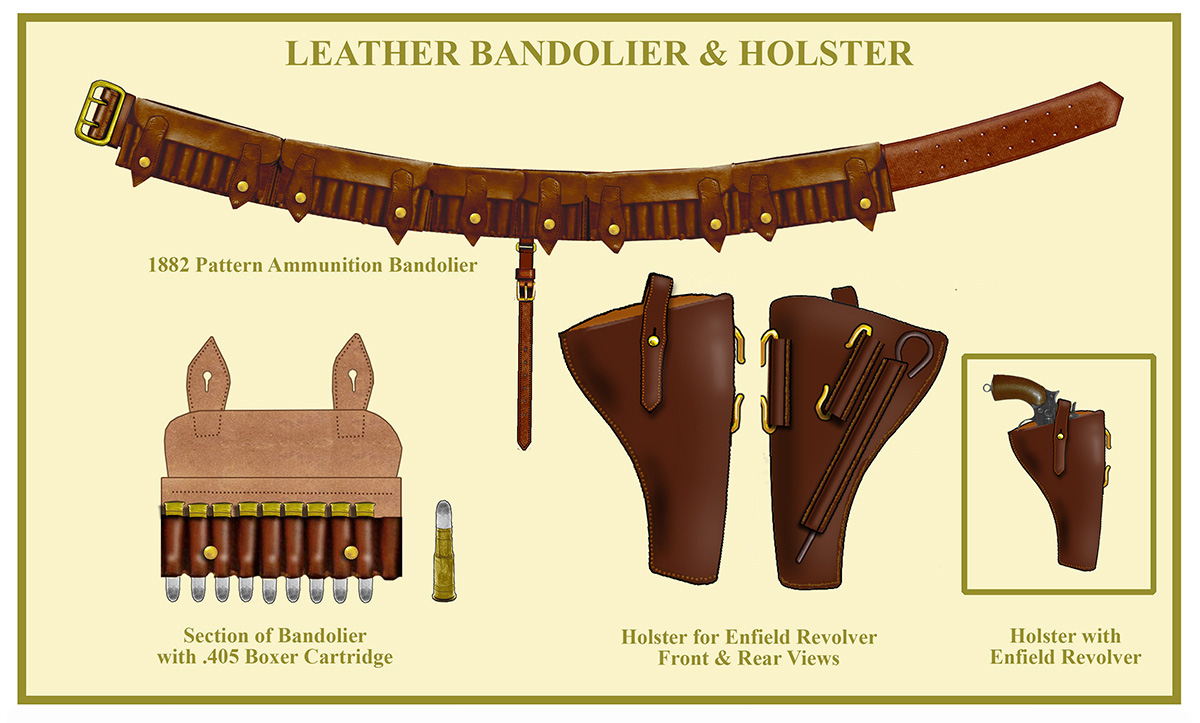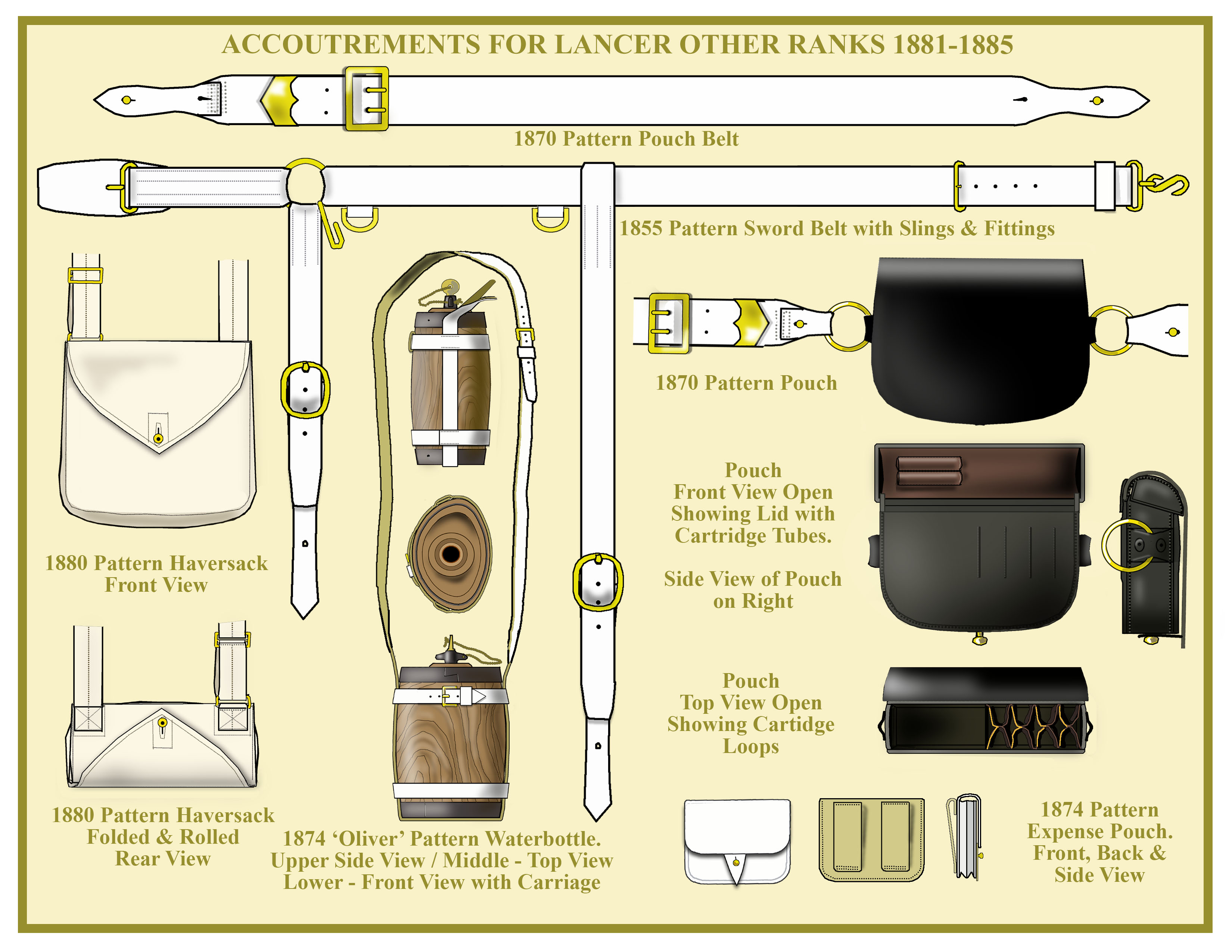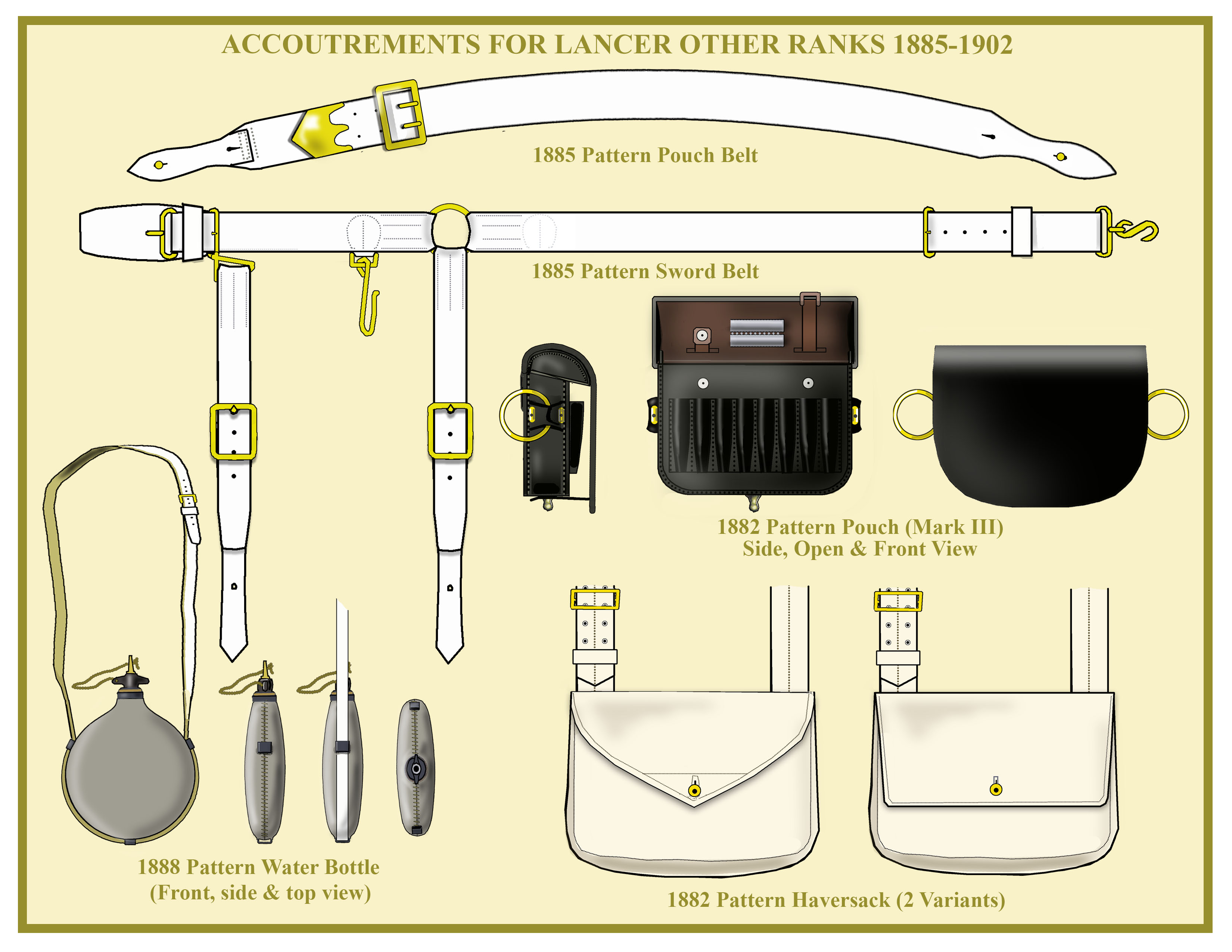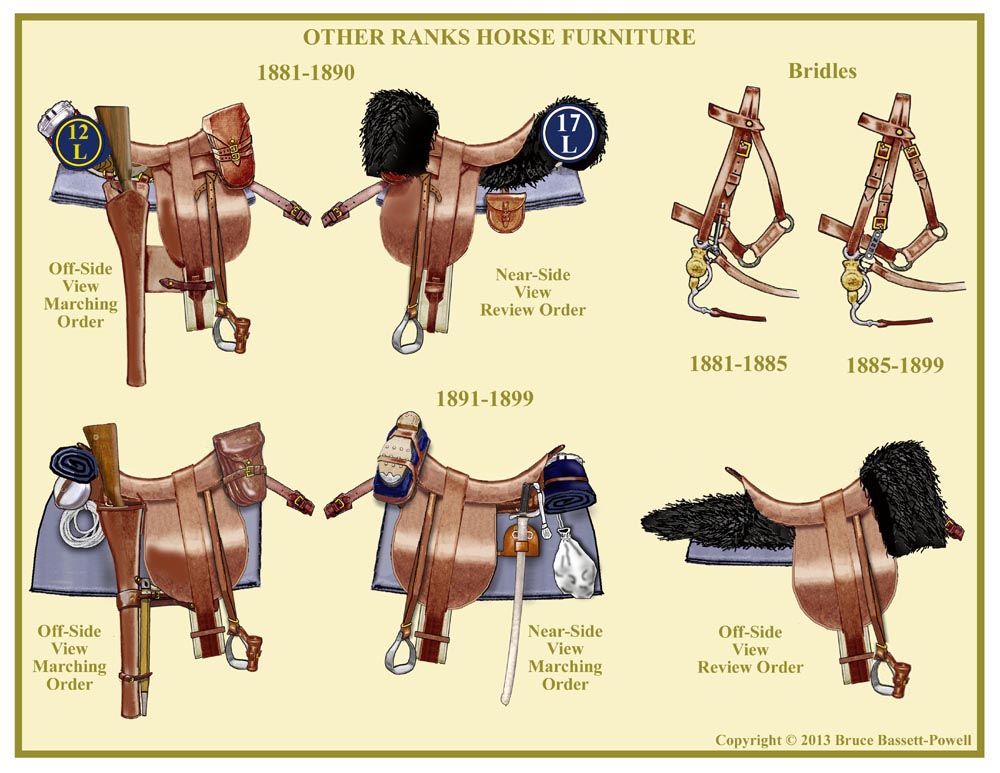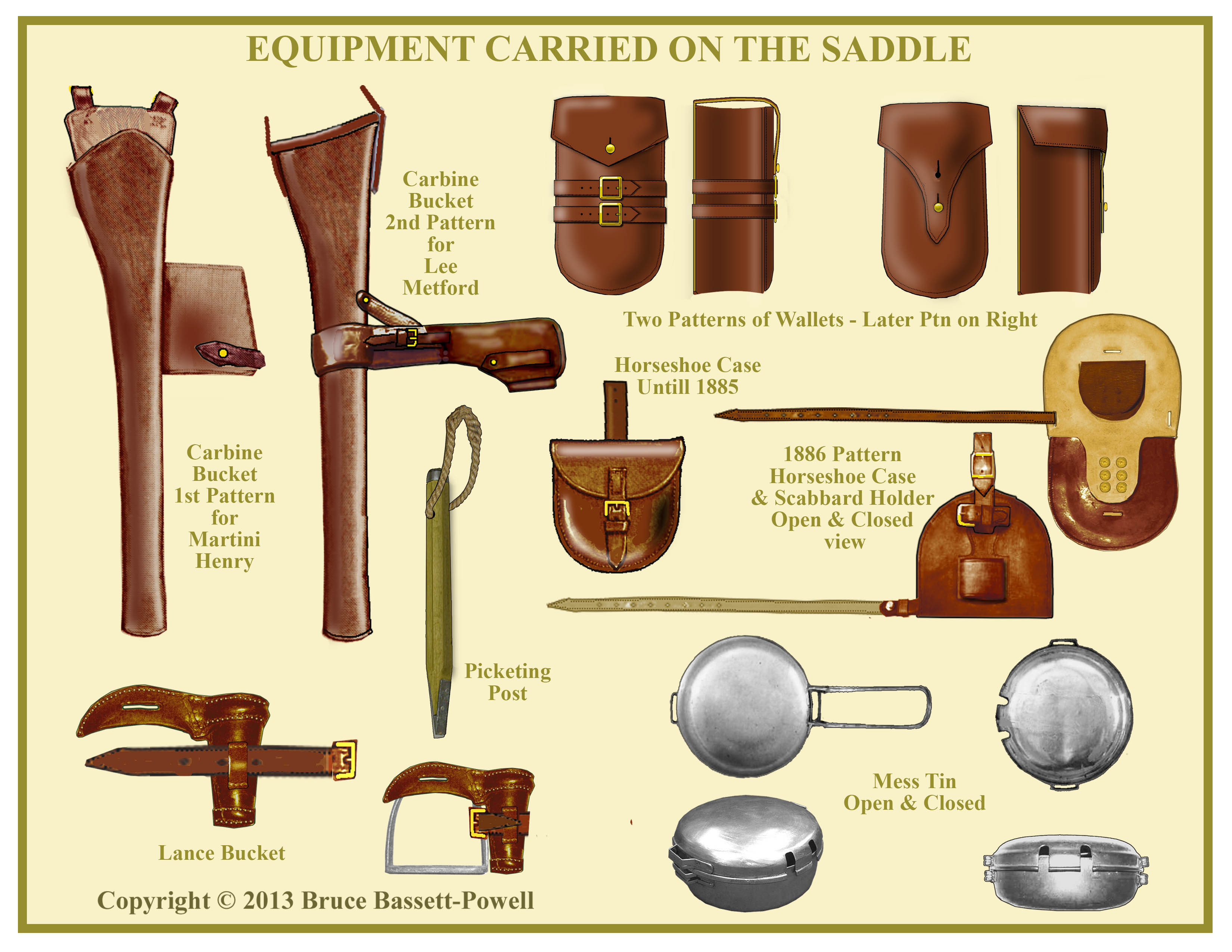LANCERS WEAPONS, EQUIPMENT & HORSE FURNITURE
With tedious regularity over the past 160 years or more, the British soldier has gone to war accompanied by a public outcry over the state of his weapons and equipment. From the Crimea to the current conflicts in Iraq and Afghanistan there has been some sort of scandal involving the quality and (usually parsimonious) procurement of such materials. Having set the scene, this account will not dwell on the details, especially as it would take a large volume to recount, but there will be mention of relevant issues concerning the various weapons as they are described.
Although the last twenty years of the nineteenth century saw drastic changes in the weaponry and equipment of the British Army, by the early years of the next century, much of it had been either abolished or relegated to ceremonial uses only.
WEAPONS
UNIFORMS, ARMS & EQUIPMENT - LANCERS
LANCES
The lancer arm of cavalry did not appear in Britain until 1816, by which time it had been in use by most of the cavalry in Europe. One event that spurred the raising of British lancer regiments was the devastating effect that the Polish lancers of Soult’s army had on the British infantry at the battle of Albuera in 1811. Henceforth, British lancers would carve a name for themselves in a number of famous cavalry charges such as Aliwal (1846), Balaklava (1854) and Omdurman (1898)
During this period the British Army carried the 1868 pattern lance which until 1885 was made of bamboo. It was 9 ft long overall and weighed 4lb 8 oz. The spear shaped pointed head was 12 ⅝ ins long and the shoe was 6 ¾ ins long. The leather thong, which was turned around the shaft several times as a grip then a loop of 13 ins top to bottom.
The swallow-tailed pennon or flag was scarlet over white, 2ft 5 ins at the fly and 9 ¼ ins at the shaft. From 1885, because the harvesting of bamboo was seasonal and hard to procure, the shaft was made of ash with the fittings being the same as for the bamboo version. The weight became 4 lb 4 ½ oz.
In 1895, it was decided by a War Office committee, that the front rank of all squadrons in the heavy cavalry regiments would be equipped with lances.
CAVALRY SWORDS
The first universal sword for the entire cavalry arm was the 1853 pattern which was modified in 1864 to a bowl guard, with pierced Maltese cross, replacing the cast-iron three bar guard (which broke regularly). This was the sword carried in all the conflicts from the Abyssinian campaign to the Egyptian campaign. The 1864 pattern sword was essentially a thrusting weapon and experiences against heavily robed native adversaries in the Third Afghan War and the Egyptian Campaign highlighted these shortcomings. In short, the sword blades were blunt and ineffective as slashing weapons. The 1882 pattern, which came in two lengths (the shorter for light cavalry), proved to be even worse and its failures, along with the infantry bayonet, led to another scandal. On this pattern the sheet steel bowl guard was lapped at the edges thereby preventing the tearing of tunic skirts which was a problem. The howl of outrage to this sword, especially during the Sudan campaign led to another reappraisal and a new testing system which produced the 1885 pattern sword. Apart from an improved and heavier blade it was no better than the 1882 version. Some modifications were made such as a pad at the top of the guard to protect the scabbard mouth. To accommodate the carrying of the sword on the saddle, the rings for the sword slings were fixed to either side of the scabbard mouth. It should be noted that most of the sword and bayonet blades used in the British Army at this time were manufactured in Solingen, Germany. However, the problem always seemed to be design rather than material. More committees and more trials followed before the 1890 pattern sword was authorized. The blade was again made heavier and more fullered and the hilt was further modified with a metal inset between the top of the guard and the grip. This sword was still not much of an improvement, but was carried for over ten years. The 1899 pattern sword, which by the time it had largely been issued was outside the scope of this account, was little different than the 1890 pattern except that the guard was again modified, this time doing away with the Maltese cross piercing and increasing the bowl size over the knuckles.
Ironically, eight years into the next century, the British produced what has been described as “the perfect cavalryman’s sword”. This pattern sword was the last in the British army as its introduction coincided with the demise of cavalry and saw little use during the Great War and it is purely a ceremonial item today.
The swords, with specifications, in use during this period are as follows:
1882 Pattern (long) - Blade Length 35⅜ ins - Weight 2lb 3 oz
1882 Pattern (Short) - Blade Length 33 ins – Weight 2 lb 2.5 oz
1885 Pattern – Blade Length 34 ½ ins – Weight 2 lb 2 oz
1890 Pattern – Blade Length 34 ½ Ins – Weight 2 lb 4 oz
1899 Pattern – Blade Length 34 ½ Ins – Weight 2 lb 9 oz
SWORD KNOTS
Unlike its German counterpart with its elaborate system of squadron colours, the British cavalry had a simple sword knot. It was a flat leather strap that was looped through a slit in the bottom of the sword hilt then formed into a fringed tassel at the end. The approximately 15in loop would go around the wrist when in action to prevent the sword falling from the hand. It had changed little since the 18th century. NCOs of cavalry had a plain un-fringed tassel. Before the 1882 pattern sword, the slit was at the top of the guard.
CARBINES & REVOLVERS
Whatever the shortcomings of the British “Arme Blanche”, there was no such problem with the firearms carried by the British cavalry at this time. The Martini-Henry single shot, breech-loading rifle with the lever action, which replaced the Snider breech-loader, was generally issued to the infantry from about 1874 and the carbine version went into production in about 1877 after extensive trials and efforts to reduce the notoriously heavy recoil. A reduced charge somewhat reduced the recoil issue and it was taken into use during the 3rd Afghan War and favourably received by the cavalry regiments who went into action with it. Thereafter the Martini-Henry carbine remained standard until well into the 1890s. It used a 0.450 Boxer cartridge, was 37 ½ ins long and weighed 7 ½ lbs. It was carried by Dragoon Guards and Dragoons on guard duty, both mounted and dismounted. The Snider carbine was the last carried on a swivel as the Martini was placed in a ‘bucket’ on the off-side of the saddle.
The .45 black powder cartridge was heavy, provided a strong recoil and contributed to the overheating of the Martini barrel. Also, the advent of the magazine now put the single shot feature at a disadvantage. The Lee-Metford bolt-action magazine rifle issued to the infantry from 1888 was issued to cavalry in a carbine version from 1894. This weapon used a .303 cartridge, had a 5 round box magazine, was 40 ins long and weighed 7.7 lbs. The timing of the Lee-Metford was somewhat unfortunate as it still used black powder and smokeless powder was developed soon after. Two years later, the Lee-Metford was converted to smokeless powder and the barrel was replaced by the Enfield version. This produced the first Lee-Enfield rifle followed in 1898 by the carbine version. Most cavalry regiments were using the six-round magazine Lee-Enfield Carbine during the Boer War which was the last cavalry carbine used by the British Army, being replaced by the universal Short Magazine Lee Enfield (SMLE) in 1902-04.
Those NCOs and soldiers permitted to use a side firearm carried the Enfield revolver for most of the period. The carrying of revolvers was also extended to trumpeters and orderlies. The Webley Mark III was issued to certain NCOs after 1895.
EQUIPMENT
Before 1885
The personal load carrying equipment carried by the cavalryman in the eighteen-seventies was much like that worn during the Napoleonic Wars; a wide shoulder belt with a cartridge pouch on the rear, a haversack for rations and personal kit and a water canteen. With the advent of the breech loading carbine in the late sixties, the swivel belt attachment disappeared and the introduction of the Martini-Henry in 1877 required reconfiguration of the pouch to accept the ammunition. British cavalrymen wore the 1857 pattern sword belt and slings with very little modification right through till 1885*. The pouch belt was the 1870 pattern which had been modified in small ways, but essentially the same. The pouch also dating from 1870 was modified in 1877 to take the .45 Martini ammunition, by removing the Snider cartridge tubes on the front. The 1882 pouch shown in the illustration was virtually the same. The haversack shown is the 1880 universal pattern for all branches of the army, with a pointed flap replacing the rounded one on the 1867 pattern. Both were worn during the eighteen-eighties. The water canteen carried was known as the “Oliver” pattern water bottle introduced for the entire army in 1874. It had a wooden body with iron loops and white leather carriage system. An expense pouch for quick access to Martini ammunition was issued in 1879. This was attached either to the lancer girdle on the right side or to the pouch belt.
After 1885
When the rings on the sword scabbard were moved to either side of the mouth to fit on the shoe-case attached to the saddle, the configuration of the sword belt and slings needed to be changed. This resulted in the 1885 pattern sword belt, which had the same snake clasp on the front but with the rear sling suspended from a ring on the back and the front sling on a moveable brass loop. This was modified slightly in 1888 with more rounded loops. Also in 1885, the pouch belt became curved to more comfortably carry the pouch. The brass fittings were changed slightly. The pouch itself went through several modifications to accommodate the changes in ammunition from .45 to .303. This was the 1892 pattern, Marks I& II followed by the Mark III in 1893 which carried 30 rounds of .303 ammunition. In 1901 the pouch belt and pouch were abolished and the sword belt became an article of equipment worn on full dress ceremonial occasions only.
In 1883 a new pattern general service haversack was authorised which was slightly shallower than the previous version and appeared in types with both rounded and pointed flaps. Needless to say, right up to the late 1890s, both the 1880 and 1883 patterns were carried. The circular iron pattern water bottle encased in light grey cloth was first issued in 1888 to troops overseas. It was not allowed for home service use until the mid-nineties. During the Boer War many were covered in khaki felt.
OTHER RANKS LEATHER EQUIPMENT
The introduction of breechloading firearms to the battlefield inevitably led to vast increases in ammunition expenditure. Bandoliers for extra cartridges soon became necessary and the first made its appearance in 1882. These were at first produced locally and mostly used by mounted infantry but their use by cavalry and other branches soon followed. They were worn by the Camel Corps in the Sudan campaigns and elsewhere. Domestic use began in about 1891 but they seem to have been restricted to mounted infantry. When the pouch and pouch belt began to be discontinued, especially on field exercises, the bandoliers were taken into use. Each bandolier carried 50 rounds in four 10 round pouches and two 5 round ones at the curvature of the waist.
The tubes on the bandolier were shortened twice before 1897 (The last pattern produced) to accommodate changes in ammunition and access. The production of ammunition in 5 round chargers for the Lee-Enfield rifles forced a re-design of the belt from 1901.
The pistol holster for use by other ranks, which by the mid-eighties was senior NCOs and trumpeters plus various orderlies, was an item that survived into the 1930s. First used to accommodate the Enfield revolver it would take most of the Webley marks from 1898 onward.
HORSE FURNITURE
As with weapons and equipment, horse furniture was generally of universal paterns throughout the cavalry arm. The following description is the same as that presented in the section on Dragoon Guards and Dragoons. There are a few minor details that have been changed to fit usage in Lancer regiments.
SADDLES & HORSE FURNITURE
Along with other elements of the British Army’s uniforms and equipment, the development of saddlery accelerated apace during the last thirty years of the nineteenth century. In line with the sections on weapons and equipment, the following account will not get deeply into construction and minutiae of saddlery and mounted equipment. It will discuss the basics of the saddles introduced and let the illustrations speak for themselves.
The first universal issue saddle came from the newly created Army Board of Ordnance in 1856. Until then there had been a distinction between saddles used in the various mounted branches of the army. The new saddle was considered very satisfactory and based on the designs of the late Captain Nolan of Balaclava fame. It was a wood arched saddle with flaps that could sustain a total weight of about 220 lbs (just over 15 ½ Stone). It went through most of the campaigns of the 1860s and 70s and in fact was in use by many Yeomanry units at the end of the century.
The second universal saddle approved by the board was that of 1872. Known as the Flat Iron Arch saddle, it failed completely with the flat iron arches giving way easily and allowing the saddle to rest on the horse’s spine. Thereafter followed change after change, the next being the Angle Iron Arch saddle of 1878. Trial examples of these were used by the King’s Dragoon Guards and 17th Lancers in the Zulu War of 1879 and found to be wanting. They preferred the old wood arched saddle. Modifications in 1882 and 1884 using steel instead of iron were still unsatisfactory and during the eighties the British cavalry found itself using a mish-mash of trial patterns on service.
Finally, in 1891 the Steel Arched Universal pattern saddle Mark I was approved. It was followed in 1893 by the Mark II and 1898 by the Mark III. All of these were a great improvement on their predecessors with a single piece seat, a higher spoon on the cantle for cavalry, wider flaps and changes to the girth with the introduction of the “V” strap.
BRIDLES
The first universal pattern bridle came in 1860 in which the snaffle bit was secured to the head collar with a T-Bar. The 1885 pattern replaced the T-Bar with a chain and buckle.
MOUNTED EQUIPMENT
The distribution of equipment on the saddle was an important factor both for the comfort of the horse and the convenience of the rider. Beneath the saddle was a folded blanket (four folds) in grey or later brown. On the Off-Side (The riders right), the saddle carried the carbine bucket (for the Martini until 1894 and then redesigned for the Lee-Metford), the picket post and rope. For riders carrying lances a lance-bucket was attached to the stirrup. On the Near-Side the horse shoe case was attached. From about 1881 to 1885 the sword scabbard could be strapped to this case. Afterward a specially designed case was introduced. The feedbag was sometimes tied to the near side rear of the saddle. At the front of the saddle, on the pommel were a pair of leather wallets which had replaced holsters in the middle of the century. On service ankle boots and cloak could be strapped on the wallets. On the rear of the saddle was a valise, a tubular cloth bag, to which was strapped the canteen. The canteen was a two part metal case which could be used as a cooking pan and a bowl. It could also carry a tin cup inside. For ceremonial purposes the sheepskin, now in two parts and black for all cavalry, was placed over the wallets in the front and over the valise in the rear. After the valise was abolished in 1895 it was worn for ceremonial purposes only.
The horse furniture with all this equipment along with a cavalryman weighing approximately 160 lbs would come to about 220 lbs.
THE VALISE
This article of equipment had been part of a cavalryman’s kit since the early 1800s and had changed very little in the meantime. It was made of cloth sometimes stiffened with buckram or canvas, 27 inches long and 6 ½ inches in diameter. It had an overlapping flap of 10 ins which secured it to the body with three straps and buckles. It attached to the cantle on a “D” ring and strapped across the fans. The opening faced the rider for convenient opening and the canteen was attached to the middle strap. It was often covered by the rear part of the sheepskin which obviously kept things dry. Its contents were supposed to be as follows. 2 pairs socks, 1 shirt, 1 pr trousers, 1 Towel, 1clothes brush, forage cap and a holdall. In 1857 the centre of the valise was hollowed out (or a void created) to ease the weight on the horses spine.
For Lancers, it was blue with designation of the regiment in yellow within a yellow circle. For the 17th Lancers it was blue with white lettering and circle. The 21st Lancers did not carry the valise as it was abolished in 1895.
THE CAVALRY HORSE
It seems appropriate that, given the fact that the horse was the main mode of conveyance for the cavalry, a few words about these magnificent, loyal and much abused animals should be said here.
It is difficult to imagine in these days that one hundred and twenty years ago, despite the advent of the railway, the principal manner of road transport was the horse. It was a living being central to life on the farm and in the country and even the city. For the army it provided the motive force for moving guns, stores, equipment and of course cavalrymen in often hostile, sometimes barren, often vast areas of the world where no other form of transport existed.
Domestically, until the mid-eighteen eighties, the system of purchasing horses for cavalry regiments rested with certain officers of the regiment who had an eye for horses. Sometimes it was the adjutant and sometimes, especially from the 1850s to the 80s it was the veterinary officer. By 1881 the most desirable horse was the English thoroughbred which should be between 14.5 and 15 hands high and be no less than 5 years old. Officers, of course purchased their own horses, the most popular being the Hunter.
In 1887 it was finally decided to create a separate department for all matters related to remounts and the Army Remount Department was born. Their responsibility was to purchase the horses, set the standards and prices. The quality of horse improved and the age limit was raised to six years before becoming a troop horse and a goal was set for at least 15 hands high.
Unlike heavy cavalry, hussar regiments did not try to have horses of the same hue and colour because they were much more likely to spend years overseas where it was unlikely to be possible. When it came to overseas service, regiments often left the shores with their horses in the transports but when on campaign, local animals were taken into service and the poor horses that left Britain often died or were cast quite quickly.
COMING NEXT
DRUM BANNERS



